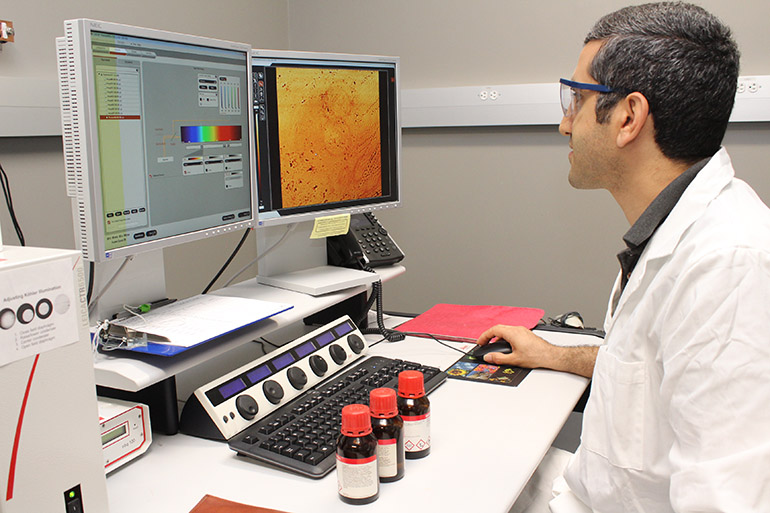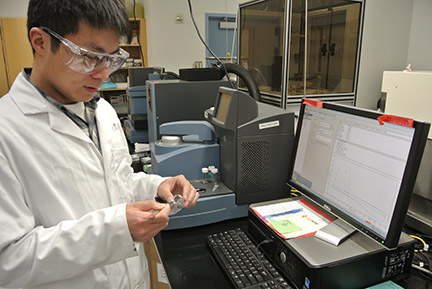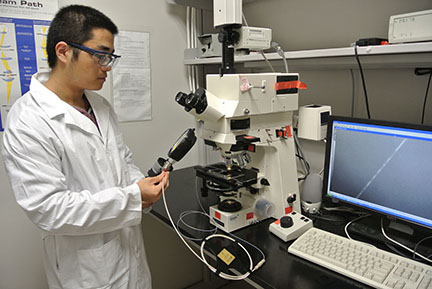
According to the National Petroleum Council, 95 percent of oil and gas wells drilled in the U.S. today are hydraulically fractured. This is because the reservoirs containing much-needed hydrocarbons that attract the attention of current U.S. production efforts are unconventional, meaning they are formed of tightly-compacted layers of shale rock. Fracturing the shale does provide better channels for flow, but hydrocarbons in these reservoirs are often confined in spaces of 100 nanometers or less. By comparison, a strand of human hair is between 80,000 and 100,000 nanometers in diameter. In these small pores, hydrocarbon reaction to changes in pressure and temperature is unexpected, often changing phase from liquid to gas in conditions not seen in conventional reservoirs made of porous rock where hydrocarbons move freely. This has a direct impact on both reservoir flow and the amount of gas and oil produced at the surface.
Dr. Hadi Nasrabadi, assistant professor in the Harold Vance Department of Petroleum Engineering, is working in collaboration with professors in the chemical and mechanical engineering departments at Texas A&M University to better explain and predict hydrocarbon phase behavior in the nanometric spaces of unconventional reservoirs.
“We are focused on pores 100 nanometers and below,” said Nasrabadi. “These pores form a significant portion of the pore volume of unconventional reservoirs. In these pores, the phase behavior is different from what we know in conventional reservoirs.”
 Nasrabadi, a Douglas Von Gonten Faculty Fellow, has studied phase behavior of hydrocarbons in conventional reservoirs for years and feels the answer to the phase behavior issues is actual experimental data. He is currently gathering this data from controlled laboratory experiments that use physical testing techniques not usually associated with normal oil and gas research.
Nasrabadi, a Douglas Von Gonten Faculty Fellow, has studied phase behavior of hydrocarbons in conventional reservoirs for years and feels the answer to the phase behavior issues is actual experimental data. He is currently gathering this data from controlled laboratory experiments that use physical testing techniques not usually associated with normal oil and gas research.
“One of the gaps I saw in phase behavior research in unconventional reservoirs was experimental work,” said Nasrabadi. “There have been several (computer) modeling efforts, but there are not as many experimental efforts, especially on the phase behavior in shale.”
Nasrabadi is working with Dr. Jodie Lutkenhaus, an associate professor in the Artie McFerrin Department of Chemical Engineering, on a technique called differential scanning calorimetry. In this technique, the sample temperature is programmed to steadily increase, and the temperature at vaporization and the heat change during the vaporization event is measured.
“(Lutkenhaus) is an expert in this technique, and she was using it for understanding the behavior of polymers in nanoscale confinement,” said Nasrabadi. “I had a meeting with her and we thought this technique could be used on hydrocarbons.”
 Their experiments, the first recorded use of differential scanning calorimetry on hydrocarbons in nanoscale confinement, are a means of accurately predicting the bubble point of hydrocarbon samples, based on heat signatures. The research is funded by the Texas A&M Engineering Experiment Station's Crisman Institute for Petroleum Research and several papers have been published documenting their work.
Their experiments, the first recorded use of differential scanning calorimetry on hydrocarbons in nanoscale confinement, are a means of accurately predicting the bubble point of hydrocarbon samples, based on heat signatures. The research is funded by the Texas A&M Engineering Experiment Station's Crisman Institute for Petroleum Research and several papers have been published documenting their work.
Nasrabadi is also collaborating with Dr. Debjyoti Banerjee from the Department of Mechanical Engineering at Texas A&M in the use of nanofluidic devices. These devices are microscopic chips with intricate nanoscopic grooves etched in a glass base.
Normally slated for biomedical and pharmaceutical research, Nasrabadi uses these chips as a housing for different hydrocarbons, which he and his students subject to temperature variations to see, under a microscope, exactly what temperature is required to change the liquid particles to a gas state. These experiments, again funded by the Crisman Institute, are also part of cutting-edge research in phase behavior studies.
Nasrabadi believes the data from both types of experiments will lead to a better understanding of the phase behavior changes, and eventually to the development of models to better predict oil and gas production from unconventional reservoirs.
“Conventional models cannot answer the questions that we have for unconventional production,” said Nasrabadi. “There are several pieces in this puzzle, but one of them is phase behavior. And nanopores may not answer all the questions, but our experiments and models show they cannot be ignored.”